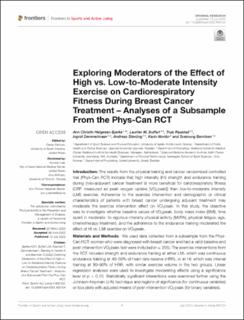| dc.contributor.author | Bjørke, Ann Christin Helgesen | |
| dc.contributor.author | Buffart, Laurien M. | |
| dc.contributor.author | Raastad, Truls | |
| dc.contributor.author | Demmelmaier, Ingrid | |
| dc.contributor.author | Stenling, Andreas | |
| dc.contributor.author | Nordin, Karin | |
| dc.contributor.author | Berntsen, Sveinung | |
| dc.date.accessioned | 2023-03-02T08:30:13Z | |
| dc.date.available | 2023-03-02T08:30:13Z | |
| dc.date.created | 2022-10-13T13:34:31Z | |
| dc.date.issued | 2022 | |
| dc.identifier.citation | Frontiers in Sports and Active Living. 2022, 4, Artikkel 902124. | en_US |
| dc.identifier.issn | 2624-9367 | |
| dc.identifier.uri | https://hdl.handle.net/11250/3055176 | |
| dc.description | This is an open-access article distributed under the terms of the Creative Commons Attribution License (CC BY). The use, distribution or reproduction in other forums is permitted, provided the original author(s) and the copyright owner(s) are credited and that the original publication in this journal is cited, in accordance with accepted academic practice. No use, distribution or reproduction is permitted which does not comply with these terms. | en_US |
| dc.description.abstract | Introduction: The results from the physical training and cancer randomized controlled trial (Phys-Can RCT) indicate that high intensity (HI) strength and endurance training during (neo-)adjuvant cancer treatment is more beneficial for cardiorespiratory fitness (CRF, measured as peak oxygen uptake [VO2peak]) than low-to-moderate intensity (LMI) exercise. Adherence to the exercise intervention and demographic or clinical characteristics of patients with breast cancer undergoing adjuvant treatment may moderate the exercise intervention effect on VO2peak. In this study, the objective was to investigate whether baseline values of VO2peak, body mass index (BMI), time spent in moderate- to vigorous-intensity physical activity (MVPA), physical fatigue, age, chemotherapy treatment, and the adherence to the endurance training moderated the effect of HI vs. LMI exercise on VO2peak.
Materials and Methods: We used data collected from a subsample from the Phys-Can RCT; women who were diagnosed with breast cancer and had a valid baseline and post-intervention VO2peak test were included (n = 255). The exercise interventions from the RCT included strength and endurance training at either LMI, which was continuous endurance training at 40–50% of heart rate reserve (HRR), or at HI, which was interval training at 80–90% of HRR, with similar exercise volume in the two groups. Linear regression analyses were used to investigate moderating effects using a significance level of p < 0.10. Statistically significant interactions were examined further using the Johnson–Neyman (J-N) technique and regions of significance (for continuous variables) or box plots with adjusted means of post-intervention VO2peak (for binary variables).
Results: Age, as a continuous variable, and adherence, dichotomized into < or > 58% based on median, moderated the effect of HI vs. LMI on CRF (B = −0.08, 95% CI [−0.16, 0.01], pinteraction = 0.06, and B = 1.63, 95% CI [−0.12, 3.38], pinteraction = 0.07, respectively). The J-N technique and regions of significance indicated that the intervention effect (HI vs. LMI) was positive and statistically significant in participants aged 61 years or older. Baseline measurement of CRF, MVPA, BMI, physical fatigue, and chemotherapy treatment did not significantly moderate the intervention effect on CRF.
Conclusion: Women with breast cancer who are older and who have higher adherence to the exercise regimen may have larger effects of HI exercise during (neo-)adjuvant cancer treatment on CRF. | en_US |
| dc.language.iso | eng | en_US |
| dc.subject | age | en_US |
| dc.subject | breast cancer | en_US |
| dc.subject | cardiorespiratory fitness | en_US |
| dc.subject | CRF | en_US |
| dc.subject | endurance and strength training | en_US |
| dc.subject | exercise adherence | en_US |
| dc.subject | intensity | en_US |
| dc.subject | moderators | en_US |
| dc.title | Exploring moderators of the effect of high vs. low-to-moderate intensity exercise on cardiorespiratory fitness during breast cancer treatment: Analyses of a subsample from the Phys-Can RCT | en_US |
| dc.type | Peer reviewed | en_US |
| dc.type | Journal article | en_US |
| dc.description.version | publishedVersion | en_US |
| dc.rights.holder | © 2022 Bjørke, Buffart, Raastad, Demmelmaier, Stenling, Nordin and Berntsen | en_US |
| dc.source.pagenumber | 9 | en_US |
| dc.source.volume | 4 | en_US |
| dc.source.journal | Frontiers in Sports and Active Living | en_US |
| dc.identifier.doi | 10.3389/fspor.2022.902124 | |
| dc.identifier.cristin | 2061169 | |
| dc.description.localcode | Institutt for fysisk prestasjonsevne / Department of Physical Performance | en_US |
| dc.source.articlenumber | 902124 | en_US |
| cristin.ispublished | true | |
| cristin.fulltext | original | |
| cristin.qualitycode | 1 | |


